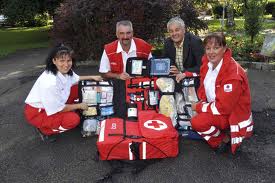Innovation: Free Port Rules
An employee has generated a good idea. Your company’s Idea First Responders have accepted the idea, stabilized it, and started to transport it to the next phase of your innovation process. And where should they take it? One good place is the Free Port.
Free Ports of old accepted ships of all nations and gave them safe harbor. That’s a good model for harboring and developing new business ideas. An Idea Free Port may be as simple as a department manager’s “good idea” file. Or it may be a prestigious, cross-departmental committee tasked with the development and implementation of good ideas. Your Free Port should adopt rules that conform to your company culture. Here are some guidelines:
- (Almost) all ideas are welcome — in general, ideas enter the Free Port via Idea First Responders (IFR). In other words, IFRs do some vetting. You can set the vetting guidelines to your company’s needs — from very stringent to very loose. All IFRs have to understand the rules in the same way. If an IFR says the idea meets the guidelines, then it enters the Free Port.
- Free Port Registry — if you encourage creativity in your company, you’ll get a lot of good ideas. You can’t implement all of them — at least, not all at once. So, one function of the Free Port is to keep track of ideas lest you forget them.
- Compare & Evaluate — since you’ll have more ideas than you can handle, the Free Port committee will need to compare ideas and decide which ones should move forward ahead of others. These are tough, often emotional decisions. A Free Port committee needs a transparent and widely accepted set of questions to evaluate ideas.. Your questions will vary depending on your needs. My favorite question is: which idea will deliver the greatest good to the greatest number of customers? Other useful questions may include: Which ideas will bring us new customers either by offering more or less than our current products offer? Which ideas would our competitors never dare to try?
- Fear of failure causes failure — business plans are based on the past. A truly innovative idea has no past — so you can’t write detailed plans for it. You have to try it out and see if it works. Sometimes it will, sometimes it won’t. The Free Port committee needs a mechanism allowing it to experiment without fear of failure. You can do this at an individual level by offering “get out of jail free” cards. At the department level (or higher), you may need a special “it may fail but let’s try it” fund.
- Free Port Reports — it will take time to organize, sort, and develop the many ideas that will enter the Free Port. Your employees will wonder what’s going on. After a while, they may even wonder if this is another cynical management ploy. The Free Port has to keep employees informed. A simple method is to publish meeting minutes. From time to time however, Free Port leaders should report to employees in person, with ample time for a robust Q&A. (You’ll develop a lot of new ideas in these sessions).
Free Ports can get bogged down in bureaucratic red tape. To avoid this, keep meetings brief and keep measurements rough. (New ideas are notoriously hard to measure. Don’t overdo it.) Also, keep the CEO involved. She can resolve disputes quickly and make the many judgment calls that need to be made. Her presence will also remind people of how important the Free Port really is.
Innovation: Idea First Responders
Companies spend a lot of time encouraging their employees to create and propose new ideas. We have training sessions, brainstorming sessions, retreats, team building exercises, ropes courses — you name it and we’ve tried it. So what happens when an employee actually proposes an idea? All too often, we kill the idea before it has a chance to breathe. We don’t do it on purpose. We do it because we’re not properly trained as Idea First Responders™.
An employee proposing a new idea is in a fragile situation. While she may believe it’s a great idea, she’s also unsure how others will respond. Will they like it? Will they support the idea? Or will they dismiss it with a roll of the eyes and a “that’ll never work here” comment. All too often, we suppress ideas without realizing it. If we suppress our employees’ first idea, it’s unlikely that they’ll come back with a second one. Why bother?
In the world of accidents and emergencies, first responders have two critical roles: stabilize and transport. The same thinking can apply to ideas. When an employee proposes an idea, we need to stabilize it and transport it to the next stage of the idea development process.
Stabilizing an idea involves several steps. The Idea First Responder (IFR) may need to flesh out the idea and help the proposer think through its various ramifications. Additionally, the proposer may have lots of questions, including some “dumb” questions. The IFR needs to answer these respectfully. Even a small amount of sarcasm can stifle the entire process. Stabilizing also means encouraging the process. The IFR needs to encourage the proposer to continue to propose new ideas, even if this one doesn’t work out.
The second stage is to transport the idea to the innovation process. This may involve asking the proposer to do more work before moving forward. When the work is completed (assuming it’s satisfactory), the Idea First Responder helps transport it into a more formal process. This may be a weekly staff meeting or it may be a more formal Innovation Committee. During the transport process, the IFR has several critical issues to tend to:
- Who champions the idea? Some proposers will want to present the idea themselves. Others will feel uncomfortable presenting an idea in a formal environment — especially if it involves senior executives. The IFR needs to sort this out. If another person is selected to champion the idea, the IFR needs to ensure that the proposer gets credit for originating the idea.
- Communicating progress. It takes time to develop an idea. The IFR needs to keep the proposer informed. Letting an idea disappear into a black hole only discourages the idea generation process.
- Breaking the good or bad news. If it’s good news, the IFR should ensure that the proposer gets formal, public recognition. If it’s bad news, the IFR needs to let the proposer know why the idea didn’t succeed and continue to encourage the process. “Well, this one didn’t work out, but senior staff really appreciates what you did and hopes you’ll think up more ideas in the future.” A nice note from the CEO can help a lot here.
Sustaining versus Disruptive Innovations
Every company wants to be more innovative. But some innovations will help your business while others will disrupt it. You need to enable sustaining innovations and defend against disruptive innovations. But sometimes, disruptive business innovations are inevitable. The only way to defend against them is to adopt them and disrupt your own business. Hey, better to disrupt your own business rather than have someone else do it for you. Right, Kodak?
Learn more in the video.
Broccoli and Innovation
 How do you stimulate innovation in your business or organization? The same way you get a kid to eat broccoli. You can’t get a kid to eat broccoli by pleading with him. Or by cajoling, or punishing, or even by withholding privileges. Telling him to “think outside the box” won’t work either. But you can lead him to broccoli — just as you can lead your business or organization to innovation. Learn how in the video.
How do you stimulate innovation in your business or organization? The same way you get a kid to eat broccoli. You can’t get a kid to eat broccoli by pleading with him. Or by cajoling, or punishing, or even by withholding privileges. Telling him to “think outside the box” won’t work either. But you can lead him to broccoli — just as you can lead your business or organization to innovation. Learn how in the video.

